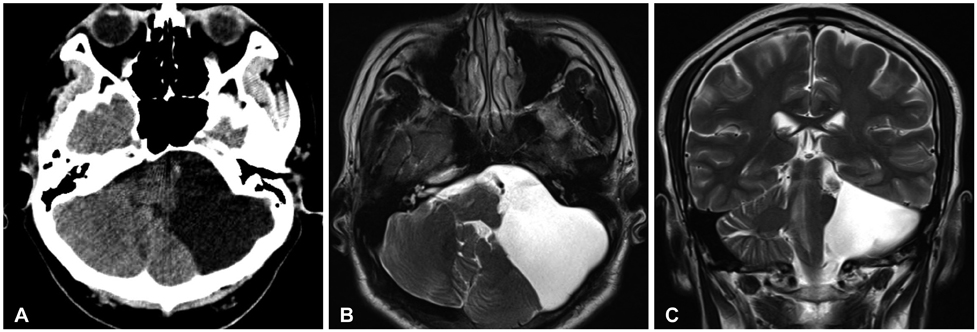Brain Tumor Res Treat.
2013 Oct;1(2):121-123. 10.14791/btrt.2013.1.2.121.
An Ependymal Cyst in Cerebello-Pontine Angle Presenting with Syncope
- Affiliations
-
- 1Department of Neurosurgery, College of Medicine, The Catholic University of Korea, Seoul St. Mary's Hospital, Seoul, Korea. medi0204@gmail.com
- 2Department of Pathology, College of Medicine, The Catholic University of Korea, Seoul St. Mary's Hospital, Seoul, Korea.
- KMID: 2048488
- DOI: http://doi.org/10.14791/btrt.2013.1.2.121
Abstract
- Intracranial ependymal cysts are rare, congenital, benign lesions. These commonly occur in the supratentorial regions and usually generate no symptoms. The cerebellopontine angle (CPA) is an extremely rare site for ependymal cysts. Furthermore, there are no previous reports of CPA ependymal cysts related to syncope. We report a case of ependymal cyst in the left CPA with syncope. The patient underwent a cardiologic evaluation for syncope after admission, but there were no definite cardiologic abnormal findings. He underwent fenestration into the subarachnoid space, and the pathologic diagnosis revealed an ependymal cyst. We analyzed this case with review of other literatures.
Keyword
Figure
Reference
-
1. Friede RL, Yasargil MG. Supratentorial intracerebral epithelial (ependymal) cysts: review, case reports, and fine structure. J Neurol Neurosurg Psychiatry. 1977; 40:127–137.
Article2. Ho KL, Chason JL. A glioependymal cyst of the cerebellopontine angle. Immunohistochemical and ultrastructural studies. Acta Neuropathol. 1987; 74:382–388.3. Nakase H, Ohnishi H, Touho H, Karasawa J. Large ependymal cyst of the cerebello-pontine angle in a child. Brain Dev. 1994; 16:260–263.
Article4. Monaco P, Filippi S, Tognetti F, Calbucci F. Glioependymal cyst of the cerebellopontine angle. J Neurol Neurosurg Psychiatry. 1995; 58:109–110.
Article5. Sharma RR, Pawar SJ, Kharangate PP, Delmendo A. Symptomatic ependymal cysts of the perimesencephalic and cerebello-pontine angle cisterns. J Clin Neurosci. 2000; 7:552–554.
Article6. Harada A, Takeuchi S, Inenaga C, et al. Hemifacial spasm associated with an ependymal cyst in the cerebellopontine angle. Case report. J Neurosurg. 2002; 97:482–485.
Article7. Ho NC, Wu HY. Ependymal cyst with hemorrhage in the cerebellopontine angle. J Clin Neurosci. 2009; 16:127–129.
Article8. Prilipko O, Dehdashti AR, Zaim S, Seeck M. Orthostatic intolerance and syncope associated with Chiari type I malformation. J Neurol Neurosurg Psychiatry. 2005; 76:1034–1036.
Article9. Reddy K, Hobson DE, Gomori A, Sutherland GR. Painless glossopharyngeal "neuralgia" with syncope: a case report and literature review. Neurosurgery. 1987; 21:916–919.
Article10. Korkes H, de Oliveira EM, Brollo L, et al. Cardiac syncope induced by glossopharyngeal "neuralgia": a rare presentation. Arq Bras Cardiol. 2006; 87:e189–e191.
- Full Text Links
- Actions
-
Cited
- CITED
-
- Close
- Share
- Similar articles
-
- MR Imaging of a Cerebello-Pontine Angle Epidermoid Cyst with a Malignant Transformation: Case Report
- Epidermoid Cyst in the Cerebello-Pontine Angle Associated with Trigeminal Neuralgia
- A Glioblastoma Occurred at Cerebello-pontine Angle: Case Report
- Trigeminal neuralgia Caused by Cerebello-pontine Angle Epidermoid Tumor
- The radiographic findings of cerebello-pontine angle lesions



